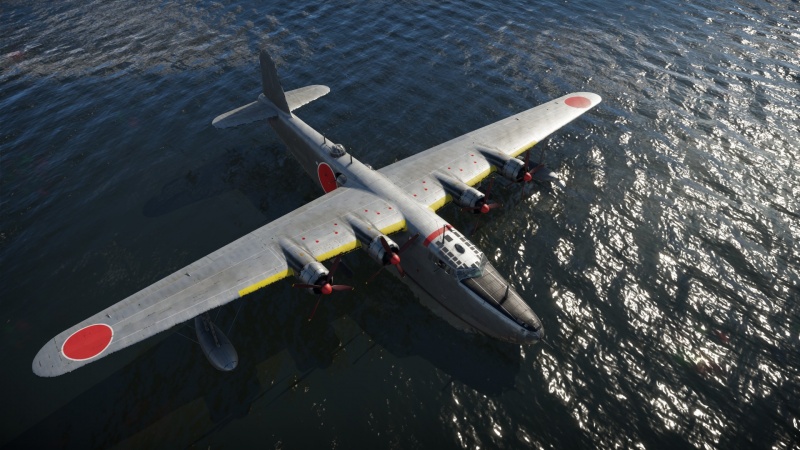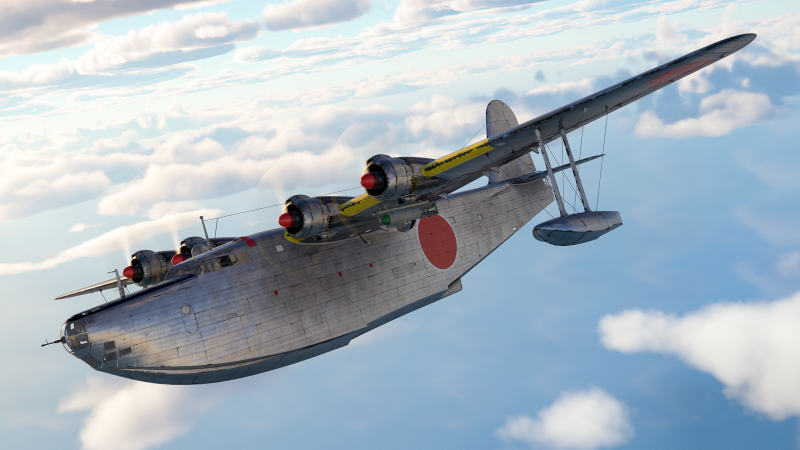H8K2
| This page is about the Japanese bomber H8K2. For the premium version, see H8K3. |
Contents
Description
The H8K2 was a variant of the Kawanishi H8K family of flying boats used by the Imperial Japanese Navy. The H8K was remarkably versatile and called "the most outstanding water-based combat aircraft of the Second World War" by aviation historian René Francillon. The H8K2 is a variant of the H8K, employing Mitsubishi MK4Q Kasei 22 engines and an improved tail gun turret. It was developed in 1943 and also fielded ASV (Air-Surface Vessel) radars on its last batch of the total 112 produced.
Introduced in Update 1.57 "Battle March", the H8K2 is a rather capable bomber for its BR. It can be compared to the German BV 238, but of course it has its differences. The H8K2 is heavy and slow, but since it is equipped with floats, it can be used in Naval Battles more effectively than other bombers. For regular battles, the H8K2 is better used as a heavy bomber, fielding a powerful defensive armament in the form of 20 mm cannons and 7.7 mm HMGs. Its large size, however, makes it an easy target for AA or interceptors. In naval battles, it can be armed with two torpedoes and, thanks to the floats, land and take off from water, allowing it to capture points, although this is extremely risky.
General info
Flight performance
| Characteristics | Max Speed (km/h at 6,000 m) |
Max altitude (metres) |
Turn time (seconds) |
Rate of climb (metres/second) |
Take-off run (metres) | |||
|---|---|---|---|---|---|---|---|---|
| AB | RB | AB | RB | AB | RB | |||
| Stock | 454 | 445 | 9500 | 33.9 | 34.8 | 3.5 | 3.5 | 750 |
| Upgraded | 500 | 476 | 32.1 | 33.0 | 10.5 | 6.5 | ||
Details
| Features | ||||
|---|---|---|---|---|
| Combat flaps | Take-off flaps | Landing flaps | Air brakes | Arrestor gear |
| ✓ | ✓ | ✓ | X | X |
| Limits | ||||||
|---|---|---|---|---|---|---|
| Wings (km/h) | Gear (km/h) | Flaps (km/h) | Max Static G | |||
| Combat | Take-off | Landing | + | - | ||
| 560 | 450 | 402 | 379 | 260 | ~4 | ~3 |
| Optimal velocities (km/h) | |||
|---|---|---|---|
| Ailerons | Rudder | Elevators | Radiator |
| < 360 | < 360 | < 360 | > 341 |
Survivability and armour
- 20mm steel plates protecting rear gunner
- 5mm steel behind pilots
- 5mm steel protecting dorsal gunner
- Self-sealing fuel tanks (6 in the mid-fuselage, 1 in each wingroot, 3 in each wing)
Modifications and economy
Armaments
Suspended armament
The H8K2 can be outfitted with the following ordnance:
- 2 x 835 kg Type 91 Model 2 torpedoes
- 16 x 60 kg Navy Type 97 Number 6 bombs (960 kg total)
- 8 x 250 kg Navy Type 98 Number 25 bombs (2,000 kg total)
- 2 x 800 kg Navy Type 99 Number 80 AP bombs (1,600 kg total)
- 2 x 800 kg Number 80 Mod. 1 bombs (1,600 kg total)
Defensive armament
The H8K2 is defended by:
- 1 x 20 mm Type 99 Model 1 cannon, nose turret (270 rpg)
- 1 x 20 mm Type 99 Model 1 cannon, dorsal turret (450 rpg)
- 1 x 20 mm Type 99 Model 1 cannon, 2 x beam turrets (270 rpg)
- 1 x 20 mm Type 99 Model 1 cannon, tail turret (540 rpg)
- 1 x 7.7 mm Type 92 machine gun, 2 x cockpit turrets (582 rpg)
- 1 x 7.7 mm Type 92 machine gun, 2 x wing root turrets (582 rpg)
- 1 x 7.7 mm Type 92 machine gun, ventral turret (582 rpg)
Usage in battles
The H8K2 can be thought of as a Japanese version of the German BV 238, and plays similarly. However, there are some key differences between the two aircraft. The H8K2 can be used in both Naval battles, and Air battles, though there are some key limitations. The aircraft has a strong defensive armament suite of ten guns (five 20 mm cannons and five 7.7 mm machine guns), and can also carry a pair of torpedoes. However, it is a very large aircraft, and is easily shot down by enemy anti-aircraft fire. In general, the aircraft should avoid close-in, frontline combat, and instead be used as a heavy bomber/support aircraft.
The first playstyle for this aircraft would be a heavy bomber in RB. The aircraft benefits from airspawn, meaning that it is much less vulnerable from interception. However, there is one key limitation to this role - the H8K2's tiny payload. The aircraft can only carry a maximum of 1,600 kg of bombs, in two 800 kg bombs. This effectively limits the aircraft to destroying a single base, which doesn't yield great bonuses. The 800 kg bombs are also ineffective against ground targets, as they drop together. This means that the only viable option against ground targets are the 60 kg bombs. However, these are also rather ineffective due to their tiny size and low explosive mass.
The second, and more interesting playstyle would be in Naval RB. The aircraft is a floatplane, meaning that it can be used to cap bases. As well, the aircraft can carry two torpedoes, which are very effective against larger vessels. Thus, the aircraft could be used as a torpedo-bomber, staying low and attacking enemies with torpedoes from a distance. However, do not approach to close to enemy naval vessels, as the H8K is massive and an easy target for enemy AAA.
When being attacked, one excellent option is the H8K's defensive armament. The 20 mm Type 99 Model 1 cannons are essentially upgraded MG FF cannons, and can do extensive damage to attacking fighters. However, take note that the aircraft has very limited protection from the underside, similar to other flying boats. Try to bait attacking fighters to your six (and slightly to the right or left), so that you can engage them with the tail, dorsal and beam turrets.
Manual Engine Control
| MEC elements | ||||||
|---|---|---|---|---|---|---|
| Mixer | Pitch | Radiator | Supercharger | Turbocharger | ||
| Oil | Water | Type | ||||
| Not controllable | Controllable Not auto controlled |
Controllable Not auto controlled |
Controllable Not auto controlled |
Separate | Controllable 2 gears |
Not controllable |
Pros and cons
Pros:
- H8K for Flying boat:
- Bomber spawn
- Landing floats
- Can capture points in Naval
- Excellent combined defensive armament
- 2 x Type 91 Aerial Torpedo
- Torpedo has the highest drop speed in the game at 580 km/h and is one of the most feared torpedoes in Naval Battles
- 16 x Type 97 No.6 Land Bomb (60 kg)
- Gets 2 x bomb racks of 8 x 60 kg bombs which can be used to hit multiple targets
- 2 x No.80 Land Bomb (800 kg)
- Heaviest bomb Japanese Navy can offer
- H8K specific:
- Decent defensive armament for its rank: 20 mm Type 99 Model 1 Cannon
- Quite fast for its size and rank
- Incredible climb rate
- Decently survivable with armour and self-sealing tanks
Cons:
- H8K for Flying boat:
- Huge target
- Lack of land-suitable gear
- Very unreliable to land on regular run-ways
- Bombs drop in series
- Common Navy plane construction:
- Poor defensive armament: 20 mm Type 99 Model 1 Cannon
- Very low muzzle velocity
- Poor defensive armament: 7.7 mm Type 92 MG
- Poor defensive armament: 20 mm Type 99 Model 1 Cannon
History
Widely recognized as the best maritime combat aircraft of WWII, the H8K2 was the main production model of the H8K series of bombers, making up 112 of the 167 total H8Ks of all variants. In 1938, just as its predecessor, the H6K, was entering service, the Imperial Navy ordered the development of a larger aircraft with longer range suited for solo bombing and patrol missions. The resulting H8K flying boats, entering service in February 1942, performed well until the end of the war, and were respected by allied pilots for their fearsome defensive armament. After the war, an H8K2 (one of only four which survived the war) was captured by American forces, and was eventually returned to Japan in 1979, where it remains on display to this day.
Media
- Skins
See also
Links to the articles on the War Thunder Wiki that you think will be useful for the reader, for example:
- reference to the series of the aircraft;
- links to approximate analogues of other nations and research trees.
External links
- [Devblog] The Aerial Cruiser of Japan: H8K2 and H8K3
- Official data sheet - more details about the performance
| Kawanishi Aircraft Company (川西航空機) | |
|---|---|
| Fighters | J6K1 |
| N1K | N1K1-Ja · N1K2-J · N1K2-Ja |
| Bombers | H6K4 · H8K2 · H8K3 |
| Hydroplane | N1K1 · E7K2 |
| Japan bombers | |
|---|---|
| Navy | |
| Carrier-based attack bomber | |
| B5N | B5N2 |
| B6N | B6N1 · B6N2 · B6N2a |
| B7A | B7A2 · B7A2 (Homare 23) |
| Carrier-based dive bomber | |
| D3A | D3A1 |
| D4Y | D4Y1 · D4Y2 · D4Y3 Ko |
| Shipboard Observation seaplane | |
| F1M | F1M2 |
| Land-based Attack bomber | |
| G4M | G4M1 |
| G5N | G5N1 |
| G8N | G8N1 |
| Flying boat | |
| H6K | H6K4 |
| H8K | H8K2 · H8K3 |
| Land-based Bomber | |
| P1Y | P1Y1 |
| Army | |
| Light | Ki-32 |
| Ki-48-II otsu | |
| Heavy | Ki-21-Ia · Ki-21-I hei |
| Ki-49-I · Ki-49-IIa · Ki-49-IIb · Ki-49-IIb/L | |
| Ki-67-I Ko · Ki-67-I otsu | |
| Other countries | ▅B-17E |






